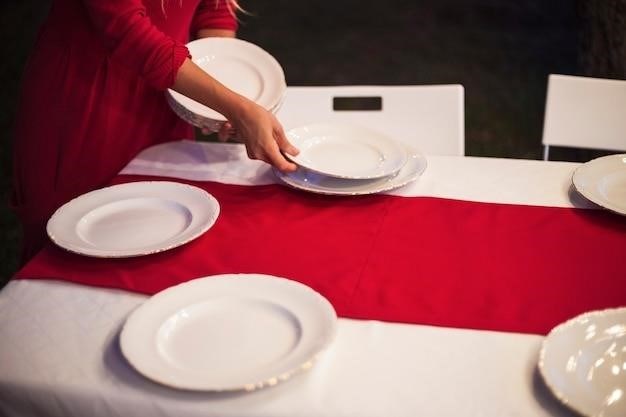Table Runner Size Guide⁚ Finding the Perfect Fit
This comprehensive guide will empower you to select the ideal table runner for any table‚ room‚ or piece of furniture. Table runners come in a variety of sizes‚ so how do you choose the perfect one? First‚ determine the purpose of the table runner. Do you want it to act as a centerpiece‚ accent a tablescape‚ or complement a room’s decor?
Understanding Table Runner Purpose
Before diving into the specifics of table runner sizes‚ it’s crucial to define your goals for using a table runner. This will guide your selection process and ensure you choose the right size and style for your needs. Consider the following questions⁚
- Centerpiece or Accent? Do you envision the table runner as the focal point of your table setting‚ or will it complement other decorative elements? A wider‚ more elaborate runner might be suitable for a centerpiece‚ while a narrower‚ simpler runner could serve as an accent.
- Formal or Casual? The occasion and desired ambiance will influence the table runner’s size and style. For a formal dinner‚ a longer‚ more elegant runner may be appropriate‚ while a shorter‚ more casual runner might be better suited for a relaxed gathering.
- Decorative Focus? What aspect of your table setting do you want the table runner to highlight? If you’re showcasing a beautiful centerpiece‚ a shorter runner that leaves the centerpiece visible might be ideal. If you want to create a cohesive look for the entire table‚ a longer runner that covers most of the surface could be preferable.
Once you’ve clarified your purpose for using a table runner‚ you can move on to determining the appropriate size to achieve your desired aesthetic and functionality.
General Table Runner Size Guide
While specific table runner sizes can vary depending on the table shape and desired overhang‚ a general guideline can help you get started. This guide offers a starting point for determining the appropriate width and length of your table runner;
- Width⁚ A table runner should generally be one-third the width of your dining table. This provides a balanced visual between the table surface and the runner. For example‚ if your table is 48 inches wide‚ the runner should be around 16 inches wide.
- Length⁚ The length of your table runner should extend beyond the table’s edges to create a stylish overhang. Aim for a minimum overhang of 5 inches on each side‚ which means the runner should be at least 10 inches longer than your table. For a more dramatic look‚ you can opt for an overhang of up to 10 inches on each side‚ adding 20 inches to the table’s length.
This general guide provides a starting point for determining the right table runner dimensions. However‚ you can always adjust these measurements based on your specific table and desired aesthetic.
Table Runner Width⁚ A Third of the Table
The width of your table runner plays a significant role in its overall visual impact. A well-proportioned width ensures the runner complements the table without overwhelming it. The general rule of thumb is to choose a table runner width that is approximately one-third the width of your dining table. This rule holds true for various table shapes‚ including square‚ rectangular‚ round‚ and oval tables.
For example‚ if your dining table is 60 inches wide‚ a table runner measuring 20 inches wide would be an ideal choice. This ratio ensures that the table runner provides a noticeable accent without dominating the table surface. The table runner acts as a visual element that enhances the table’s aesthetics without detracting from the overall dining experience. It adds a touch of elegance and style to any dining setting.
However‚ feel free to adjust this guideline based on your personal preferences. If you prefer a more prominent runner‚ you can opt for a slightly wider option‚ but remember to maintain a balance to ensure the runner complements the table’s overall design.
Table Runner Length⁚ Overhang for Style
The length of your table runner is equally important in achieving the desired aesthetic. While simply covering the length of the table is functional‚ adding a stylish overhang is what truly elevates the look. A well-placed overhang adds visual interest and creates a sense of balance and proportion. A table runner that extends beyond the table’s edge creates a more polished and sophisticated look.
Aim for an overhang that ranges between 5 to 10 inches on each side. This means your table runner should be at least 10 inches longer than the length of your table and‚ at most‚ 20 inches longer. For instance‚ if your table measures 60 inches long‚ your table runner should be between 70 and 80 inches long. This overhang provides a graceful drape and adds a touch of elegance to your tablescape.
The overhang creates a visually appealing focal point‚ drawing the eye to the center of the table. It also adds a touch of formality‚ making your dining setting more elegant and inviting. A perfectly sized overhang can transform your table into a visually stunning centerpiece‚ setting the perfect mood for any gathering.
Table Runner Sizes for Different Table Shapes
The shape of your table plays a crucial role in determining the ideal table runner size. Different shapes require different approaches to ensure the runner complements the table’s form and enhances its visual appeal; Here’s a breakdown of size recommendations for common table shapes⁚
Round Tables
Round tables offer a sense of symmetry and elegance. When choosing a table runner for a round table‚ the width should be approximately 14 inches. This width creates a visually pleasing balance without overwhelming the table’s circular form. The length will depend on the table’s diameter and your personal preference‚ but a good guideline is to have the runner extend 6 to 12 inches beyond the table diameter on each side. This creates a graceful overhang that enhances the table’s circular shape.
Square and Rectangular Tables
For square or rectangular tables‚ the general rule of thumb is to choose a table runner that’s about 1/3 the width of the table. For example‚ if your table is 60 inches wide‚ the table runner should be approximately 20 inches wide. The length should be determined by the table’s length‚ with an overhang of 5 to 10 inches on each end.
Round Tables
Round tables‚ with their inherent symmetry‚ present a unique opportunity for table runner styling. They exude an air of elegance and sophistication‚ making them a popular choice for dining and entertaining. When selecting a table runner for a round table‚ the width should be approximately 14 inches. This width creates a visually pleasing balance‚ complementing the circular form without overwhelming it.
The length of the table runner will depend on the size of the table and your personal preference. However‚ a general guideline to consider is that the runner should extend 6 to 12 inches beyond the table’s diameter on each side. This graceful overhang enhances the table’s circular shape‚ adding a touch of visual interest and creating a more polished appearance.
Square and Rectangular Tables
Square and rectangular tables are the most common shapes found in dining rooms. They offer versatility and adaptability‚ accommodating various seating arrangements and serving styles. When selecting a table runner for these table shapes‚ it’s crucial to consider both width and length to achieve a harmonious and visually appealing outcome.
For square and rectangular tables‚ the standard width for a table runner is approximately one-third the width of the table. This proportion ensures the runner complements the table’s dimensions without appearing too narrow or overly dominant; As for the length‚ aim for an overhang of 12 to 20 inches beyond the table’s length on each side. This overhang adds a touch of elegance‚ creating a more formal and visually balanced look.
Remember to measure your table carefully before purchasing a table runner‚ ensuring that the runner you choose is the perfect size to enhance your dining experience.
Oval Tables
Oval tables bring a touch of elegance and sophistication to any dining space. Their curved shape creates a sense of flow and intimacy‚ making them ideal for both formal and casual gatherings. While oval tables offer a unique aesthetic‚ they can sometimes pose a challenge when it comes to finding the perfect table runner size.
The key to choosing the right table runner for an oval table lies in ensuring a consistent overhang on both ends. Aim for a table runner that extends 12 inches or more beyond the length of the table. This overhang creates a balanced and visually appealing look‚ enhancing the oval shape’s natural elegance.
Consider the table’s size and the occasion when determining the ideal overhang. For smaller oval tables‚ a 12-inch overhang may suffice‚ while larger tables might benefit from a 15 to 20-inch overhang. Remember‚ the goal is to create a harmonious and visually pleasing arrangement that complements the table’s shape and enhances the overall dining experience.
Table Runner Size for Specific Table Lengths
Determining the ideal table runner size for a particular table length requires a balance of practicality and aesthetics. While a general guideline suggests an overhang of 12 to 20 inches‚ specific table lengths often require tailored considerations.
For example‚ a 6-foot long table (72 inches) typically calls for a table runner measuring 84 inches in length. This provides a 6-inch overhang on each side‚ creating a balanced and stylish look. However‚ personal preference and the desired aesthetic can influence the chosen overhang. Some may prefer a more minimal overhang‚ while others might opt for a more dramatic drape.
For longer tables‚ such as those measuring 72 inches or more‚ a longer table runner is recommended. Consider a 90-inch or even a 108-inch runner to accommodate the extended length and ensure a visually appealing overhang. Remember‚ the key is to choose a runner that complements the table’s size‚ ensuring a harmonious balance between the table surface and the runner’s overhang.
Table Runner Size for an 8-Foot Table
When choosing a table runner for an 8-foot table (96 inches)‚ the goal is to achieve a visually pleasing and proportionate look. The general rule of thumb is to aim for a runner that is approximately two-thirds the length of your table.
Applying this rule to an 8-foot table‚ two-thirds of 96 inches equals 64 inches. Therefore‚ an ideal table runner for an 8-foot table should be close to 64 inches in length. This will provide an overhang on each end of the table while maintaining a balanced and aesthetically pleasing look.
However‚ you can adjust the runner’s length based on your personal preference and desired aesthetic. For example‚ you might choose a slightly longer runner to create a more dramatic drape or a slightly shorter runner for a more minimalist look. Ultimately‚ the key is to select a runner that complements the table’s size and creates a visually appealing and harmonious setting.
Choosing the Right Table Runner Size⁚ A Summary
Selecting the perfect table runner involves a blend of practical considerations and aesthetic preferences. By understanding the basics of table runner sizing‚ you can effortlessly create a visually appealing and harmonious setting for any occasion. Remember‚ a good rule of thumb is to choose a runner that’s approximately one-third the width of your table and overhangs the table by 6-12 inches on each side;
However‚ the specifics will vary depending on the shape and size of your table‚ as well as your personal style. For round tables‚ the runner should extend 6-12 inches beyond the table diameter on each side. For square and rectangular tables‚ ensure the runner is at least 12 inches longer than the table length. When it comes to oval tables‚ aim for a runner that’s at least 12 inches longer than the table.
Ultimately‚ the perfect table runner size will depend on your individual needs and preferences. By carefully considering your table shape‚ size‚ and the desired look‚ you can create a table setting that exudes both elegance and functionality.



